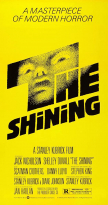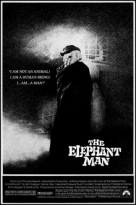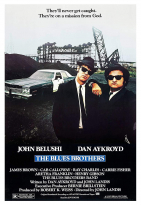Looking Through Time: 1980 Movies
The CommRadio Arts & Entertainment Staff revisits some of the most influential films from 1980.

“Star Wars: The Empire Strikes Back”
“Star Wars: The Empire Strikes Back” is a crucial film for its genre. It was the second Star Wars film ever released and it left audiences with one of the greatest and most well-known twists in fictional history: “No, I am your father.”
This line from Darth Vader to a rather beaten and bruised Luke Skywalker is a line that shocked viewers and changed the course of Star Wars forever. Not to mention, the movie contains other cliffhangers as well, such as the state of the Rebel Alliance after the movie's opening battle on the icy tundras of Hoth, to the fate of everyone's favorite smuggler, Han Solo, being frozen in carbonite.
As with all Star Wars films, the score is one of the best in the industry. Constructed from the brilliant mind of John Williams, the score gives the perfect background theme to every scene, and sets an amazing tone.
The special effects were considered cutting edge at the time. Audiences were astounded with how the movie looked and pulled off some of its scenes.
The puppeteering worked incredibly well at the time and while it could be perceived as “dated,” it’s still miraculous how most of Star Wars was shot using the models, puppets, and other devices to bring the universe to life.
The overall plot of the movie was fantastic too, following Luke on his journey to become a Jedi and face Darth Vader, all while showing us what becomes of his friends in the wake of the Imperial invasion mentioned above.
It would also be a mistake not to mention that the film introduced viewers to bounty hunter Boba Fett, who accrued so much popularity, in spite of little screen time, that he still has a major fanbase today.
The film was a major topic of conversation, be it on the streets or in the schools; people heard about it everywhere. While “A New Hope” certainly gave Star Wars the ground it needed to run on, “Empire Strikes Back” was the film that gave it velocity. — Colton Pleslusky

“Airplane”
“Airplane” is a hugely important comedy film as it was one of the first parody films. This film never took itself seriously.
“Airplane” is one of the funniest movies ever made. There is never a dull moment, and the cast of this film has the time of their lives.
Leslie Nielsen is the standout actor in this film. Nielsen is one of the best comedians of all time and every single one of his jokes in this film lands in a spectacular fashion.
This film is highly regarded as the funniest movie of the year and it successfully spoofs all the disaster movies from the 1970s. “Airplane” is the king of the 1980s spoof films and it deserves its crown.
Each time viewers watch this film, they will discover more references and more visual gags. This movie has a lot of charm and although each character is the bud of the joke, they are all loveable and interesting characters.
This movie also has an intriguing love story. Both protagonists are perfect for each other, as their backstory together is both hysterical and heartwarming.
Because of the great acting by Julie Hagerty and Robert Hays, it is easy for the audience to root for them.
This movie is an example of all the spectacular comedic films that came out in the 80s, and although spoof films have been lackluster in the previous years, this film is outlandish and a good time.
“Airplane” is such a fun movie that it will have viewers laughing from start to finish. One may say, “surely you can’t seriously love this movie.” Well, I am serious and don’t call me Shirley. — Jack Fresier

“The Shining”
Even if one has never seen Stanley Kubrick’s “The Shining,” there is a good chance they’ve seen it referenced across many different forms of pop culture.
Just like everyone knows the first rule of “Fight Club,” the phrase, “here’s Johnny” can be referenced anywhere.
People will picture Jack Nicholson’s psychotic face peering through the man-made hole in the door, too.
While the scare factor of “The Shining” may not hold up in today’s desensitized world, the Stephen King inspired story is able to achieve something most horror movies cannot: simply being a good movie.
Instead of the typical slasher film or ghost story, “The Shining” devolves into one’s inner psyche, where the viewer’s mind is manipulated just like the characters on screen, unsure of what is real and what is otherworldly. Seeing
Nicholson’s Jack Torrance slowly become consumed by the Overlook Hotel is one of the darkest character arcs ever written.
Kubrick drew heavy inspiration from David Lynch’s debut film, “Eraserhead,” attempting to push the horror genre in a direction that audiences had never seen. Lynch’s sickly take on parenthood through a slew of disturbing images produced via one’s deteriorating mind was the perfect source for Torrance’s fate.
John Alcott’s cinematography created some of the most prolific shots in film, whether it be the above view of the hotel’s garden labyrinth or the iconic scene of young Danny riding his toy tricycle through the halls of the inn.
The true horror of “The Shining” stems from what happened behind the scenes. The criticism that Shelly Duvall has received should be ignored as Kubrick pushed her mentally in order to get the best from her. The look on her face throughout the film draws a fine line between acting and real life.
As a fan of ambiguity in movies, “The Shining’s” eerie, and for some, confusing ending is one of the greatest conclusions to grace film.
To this day, viewers ponder what it all truly means, yet no matter what the verdict is, Kubrick’s final shot will act as the perfect culmination for his demented tour de force. — Joe Eckstein

“The Elephant Man”
Upon finishing “The Elephant Man,” the viewer might want to confirm that the film they just saw was made actually in 1980. They may also look into the real-life case of the main character.
This historical drama was directed by David Lynch, who also received credit for sound design. Notable performances included Anthony Hopkins as Dr. Frederick Treves, the physician who rescued “The Elephant Man.” The title character was portrayed by the late Sir John Hurt.
The story was based on actual accounts taken from Joseph Merrick’s life. In the film, his first name was John.
“The Elephant Man” was the name of Merrick’s act when he was employed in the freak show. His extreme deformities gave him limited options for work since his movement and speech was hindered.
Bringing Merrick to life for production was a grueling ordeal for Hurt. Hurt had to show up before 6 a.m. to begin the process of applying make-up, which was cast from Merrick’s real-life body that was preserved since his death.
Hurt complained about the cosmetics and how it restricted his mobility during filming. The result made Hurt’s appearance and speech unrecognizable as he became Merrick essentially. Hurt’s story was told in the environment that he lived in, which was recreated through the atmosphere.
The style of cinematography used in “The Elephant Man” allows it to resemble motion pictures that were made in the 1940s. One notable feature is that it was filmed completely in black and white.
Characters were framed in the setting of Victorian London, which was depicted as hostile through the effort of cinematographer Freddie Francis. This, combined with the scarcity of music throughout, creates an environment for a story that displays struggle.
One of the themes is Merrick’s return to humanity. The freak show owner, played by Freddie Jones, treats Merrick like an animal and refers to him as “it” rather than “he.” Both the owner and Dr. Treves displayed Merrick as an object in different ways: one for amusement, the other for study and treatment.
Treves provides Merrick with a room and seeks to understand him and over time, Merrick reveals that behind his rough exterior is a well-refined man.
“The Elephant Man” was a commercial and critical success when it came out and was nominated for eight academy awards including Best Picture and Best Actor for Hurt’s portrayal. This film would be well received by everyone and it carries the message that although we look different, we are all human. — David Myers

“The Blues Brothers”
Directed by John Landis, “The Blues Brothers” is a classic 1980s musical comedy starring John Belushi and Dan Aykroyd.
The characters, Jake and Elwood Blues, were first developed in a recurring sketch on “Saturday Night Live.” The brothers claim fame for their infamous outfits that have made them easily recognizable and memorable today: black suits, black fedoras and black sunglasses.
Before shooting, Belushi noted that he did not listen to blues music, the music produced throughout the entire movie. On the other hand, Aykroyd stated that he lives and dies for the blues.
Aykroyd quickly got Belushi hooked.
Despite being behind schedule and quickly burning through the budget, Landis cultivates this masterpiece.
From high-speed chases, sketchy gigs and a crazy ex-wife, there is never a dull moment in this wildly creative film.
The beginning of the “The Blues Brothers” depicts their dicey upbringing in an orphanage. The two take a visit to their old home and learn that the establishment is $5,000 behind in taxes. The brothers come up with an elaborate plan to raise money and get their old band back together to help. They are on “a mission from God.”
A thread throughout the entire movie is the element of the chase. The brothers are running from the police, which brings a level of suspense and high-power energy.
The R&B Soundtrack and musical appearances from Aretha Franklin, Ray Charles, James Brown and the cast exemplify the film as a whole.
One of the most famous scenes in “The Blues Brothers” is when the two sing “Everybody Needs Somebody” backed by their fellow band members. Those who doubted the brothers quickly changed their minds, even the officers and S.W.A.T team barricading the doors of the auditorium.
Although this movie was created in 1980, it is still a part of pop culture, and audiences love it to this day. — Courtney McGinley

“Caddyshack”
The 1980 sports comedy film “Caddyshack” may now be a classic, but it faced many obstacles before developing the cult following it has today.
The film centers around a teenage boy, Danny, who works as a caddy at his local country club to raise money for his college education. While working at the Bushwood Country Club, he is exposed to the lifestyle of wealthy club members and golfers.
“Caddyshack” featured two stars best known for their work on “Saturday Night Live,” Chevy Chase and Bill Murray. It launched the career of comedian Rodney Dangerfield, who played club member Al Czervik.
Their individual performances, along with Ted Knight as Judge Elihu Smails and Michael O’Keefe as Danny, are arguably the most successful part of the movie.
“Caddyshack” was directed by Harold Ramis and produced by Douglas Kenney. Ramis and Kenney also wrote the film along with Brian Doyle-Murray. The idea for “Caddyshack” came about after the success of “Animal House” in 1978, which Ramis and Kenney wrote with Chris Miller.
“Animal House” is a comedic telling of the college experience and was the first film produced by the popular satirical magazine “National Lampoon.” The magazine, though controversy, spawned a comedic empire and launched the careers of many up-and-coming comedians.
Although it is now described as the “funniest sports movie ever made” by ESPN, “Caddyshack” was initially considered a box office failure and received many negative reviews from critics.
It was only the 17 most successful American film in 1980 despite expectations that it would surpass the number three spot that “Animal House” had earned in 1978.
The film was filled with comedic moments, but the structure was overall disorganized, which confused viewers. It was also overshadowed by bigger hits that year, such as “The Blues Brothers” and “Star Wars: The Empire Strikes Back.”
After the creators’ initial success with “Animal House,” audiences were expecting something more along those lines.
Kenny Loggins’ single, “I’m Alright,” was featured in the opening sequence of the film and audiences still associate the song with the classic gopher. There were four songs by Loggins featured on the “Caddyshack” soundtrack.
Filmed in the drug-fueled era of the 70s and 80s, alcohol and drugs had an extreme presence on the set of “Caddyshack.” There was incessant use of cocaine, alcohol and other substances by the actors and crew members on set.
Though this was dangerous and unprofessional, perhaps it’s something that makes the film unique. The impulsive nature on set made some of the most memorable scenes in “Caddyshack” possible, such as the improvised dialogue and dangerous stunts.
The cultural impact of “Caddyshack” has evolved throughout the years, but the comedic legacy it created is unmatched. It launched the careers of many young writers and actors and contains many iconic scenes and quotes. The Murray brothers even opened a Caddyshack restaurant inspired by the film in Florida in 2001. — Sarah Simpson
Colton Pleslusky is a junior telecommunications major. To contact him email csp5289@psu.edu
Sarah Simpson is a junior majoring in Film-Video. To contact her, email sus816@psu.edu
Courtney McGinley is a freshman majoring in broadcast journalism. To contact her, email cbm5861@psu.edu
David Myers is a junior majoring in telecommunications. To contact him, email at d12amyers@gmail.com
Joe Eckstein is a junior majoring in broadcast journalism. You can contact him at jojoeck62@gmail.com.
About the Contributors

David Myers
Fourth-year student / Telecommunications
David Myers is a fourth-year student from Watsontown, Pennsylvania. He is a member of the student-run radio station CommRadio at Penn State. He is in the arts & entertainment department.

Colton Pleslusky
Fourth-Year / Telecommunications
Colton S. Pleslusky is a fourth-year from Aliquippa, Pennsylvania majoring in telecommunications at Penn State. He is a director and writer for the CommRadio Arts & Entertainment Department as well as the host on Nittany Stories and a co-host on Nittany Record Club alongside Emily McGlynn. He does behind the scenes tasks, including directing, producing, programming and more for the Centre County Report. To contact him, email .(JavaScript must be enabled to view this email address) or .(JavaScript must be enabled to view this email address).

Courtney McGinley
Sophomore /
Courtney McGinley is a Sophomore from Pittsburgh, PA, and is majoring in Broadcast Journalism with a minor in Business. She serves as a News Reporter for CommRadio. In addition to CommRadio, she is a Field Reporter for PSNtv and an Entertainment Reporter for the Nittany Lion Red Carpet Network. Her twitter handle is @court_mcginley.

Sarah Simpson
Senior / Film-Video
Sarah Simpson is a senior from Irwin, Pennsylvania majoring in film-video, and minoring in Journalism and Spanish at Penn State. She is a member of Centre County Report. She is also the president of Penn State Network Television (PSNtv), Penn State’s student-run television network, as well as the director for PSNtv’s weekly news broadcast PSN News. She has interned with the Pittsburgh Post-Gazette as a photo/video intern and Penn State Athletics as a live video production intern. If you’d like to contact her, email .(JavaScript must be enabled to view this email address).

Joe Eckstein
Fourth year / Broadcast Journalism
Joe Eckstein is a fourth year for Nazareth, Pennsylvania majoring in broadcast journalism. He is a contributor for the CommRadio. He also is the opinion editor for The Daily Collegian. He was a former intern with The Morning Call newspaper in Allentown. To contact him, email him at .(JavaScript must be enabled to view this email address)

Jack Freiser
Third-Year / Telecommunications
Jack Freiser is a third-year student in the Donald P. Bellisario College of Communications at Penn State University studying telecommunications. He is very passionate about both music and film. He aspires to impact the music business as a successful A+R by signing artists who will be culturally relevant and will leave an impact on the world, and through keeping a strong relationship with the artist and their team. Email him at .(JavaScript must be enabled to view this email address).








